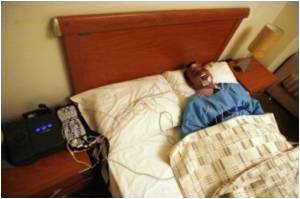A study in the Oct. 15 issue of the Journal of Clinical Sleep Medicine found that adults with fibromyalgia had a much higher prevalence and risk of

"Sleep disruption is common in fibromyalgia, and often difficult to treat," said contributing author Dr. Nathaniel F. Watson, associate professor of neurology at the University of Washington in Seattle, Wash. "It is apparent from our study that a substantial portion of sleep disruption in fibromyalgia is due to restless legs syndrome."
The research team led by Dr. Watson and lead author Dr. Mari Viola-Saltzman of Loyola University Medical Center in Maywood, Ill., studied 172 people with fibromyalgia who had a mean age of 50 years; 93 percent were female. They were compared with 63 healthy controls who had a mean age of 41 years.
Fibromyalgia was identified by self-report or review of the medical records, and it was confirmed on examination according to published guidelines regarding the presence of pain that is chronic and widespread. Pain was assessed by subjective report and by objective measurement with a dolorimeter, a spring-loaded gauge that is used to apply standardized rates of pressure to tender points on the arms and legs.
According to the National Institute of Arthritis and Musculoskeletal and Skin Diseases, fibromyalgia can cause significant pain and fatigue. It is estimated to affect 5 million Americans age 18 or older, and between 80 and 90 percent of those diagnosed with fibromyalgia are women. The causes of fibromyalgia remain unknown.
Restless legs syndrome was diagnosed using a self-administered, validated questionnaire. RLS is a sleep-related movement disorder that involves an urge to move the legs that is usually accompanied or caused by uncomfortable and unpleasant sensations in the legs. This urge begins or worsens during periods of rest or inactivity, is partially or totally resolved by movement, and worsens or only occurs at night. RLS occurs 1.5 to two times more commonly in women than in men.
Advertisement
"Since restless legs syndrome is a treatable condition, diagnosing and treating RLS in fibromyalgia patients has the potential to improve their sleep," Watson said.
Advertisement
Source-Eurekalert













